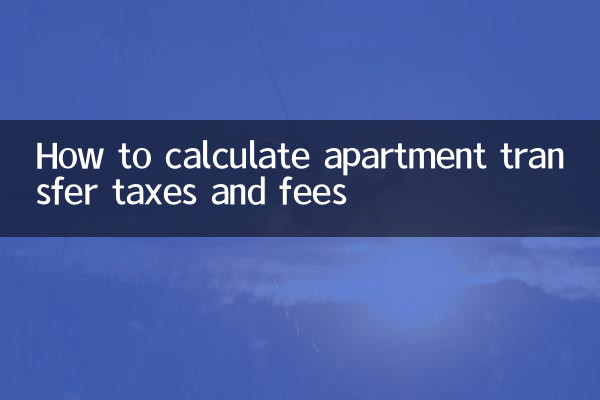How are apartment transfer taxes calculated? Detailed explanation of the latest policies in 2024
Recently, real estate transaction tax policies have become a hot topic. In particular, the calculation of taxes and fees involved in apartment transfers is complicated, and many home buyers have questions. This article will provide you with a detailed analysis of the calculation method of apartment transfer taxes and fees based on the hot topics on the Internet in the past 10 days, and attach a structured data table to help you quickly grasp the core points.
1. Main components of taxes and fees for apartment transfer

| Tax type | Collection standards | Calculation method | collector |
|---|---|---|---|
| VAT | held for less than 2 years | Transaction price × 5.3% (including additional fees) | seller |
| personal income tax | Not the only housing | (Transaction price - original value) × 20% or Transaction price × 1% | seller |
| Deed tax | Buyer's first home | Transaction price×3% | buyer |
| land value added tax | commercial nature | Added value×30%-60% | seller |
| stamp duty | both sides | Transaction price×0.05% | buyers and sellers |
2. New policy changes in 2024
1.Adjustment of value-added tax exemption period:Pilot projects in many places have shortened the value-added tax exemption period for apartment holdings from 5 years to 2 years, but it is necessary to pay attention to the differences in local implementation details.
2.Deed tax subsidy policy:Some cities have introduced deed tax subsidies for commercial apartments (such as Hangzhou and Chengdu), with subsidies up to 50%. Please pay attention to the announcements of the local housing and construction department.
3.Land value-added tax approved collection rate:Starting from 2024, the approved collection rate of commercial real estate land value-added tax will generally be reduced by 1-2 percentage points. Please refer to local tax bureau documents for details.
3. Calculation of typical cases (taking 1 million apartments as an example)
| situation | Holding period | seller tax | Buyer taxes | total |
|---|---|---|---|---|
| Case 1 | Over 2 years | Personal tax 10,000 + land value-added tax 30,000 | Deed tax 30,000 + stamp tax 500 | 75,000 |
| Case 2 | Less than 2 years | VAT 53,000 + personal tax 10,000 + land value-added tax 30,000 | Deed tax 30,000 + stamp tax 500 | 128,000 |
4. Saving Money Tips
1.Make good use of the "full two only" policy:If the seller has held the property for more than 2 years and it is the family's only commercial property, the property is exempt from VAT.
2.Verify the original value certificate:Providing a complete house purchase invoice can reduce the tax base of land value-added tax, and some cities allow a deduction of 30% of the invoice amount.
3.Pay attention to local policies:For example, if Shenzhen allows commercial apartments to levy deed tax (1.5%) according to residential standards, they must proactively provide supporting materials.
5. Things to note during the handling process
1. Prepare in advanceReal estate certificate, ID card, sales contractOriginals and copies of other materials.
2. It is recommended to proceedTax pre-approval, some regional tax authorities provide online calculators (such as Shanghai's "One-on-one" platform).
3. AttentionFund supervisionRequirements, commercial real estate transaction capital supervision ratio is usually higher than that of residential real estate transactions.
4. Promptly handle the transfer of ownershipWater, electricity and gas transfer, commercial apartments need to apply separately for business change and residence change procedures.
According to the latest market research data, the transaction volume of commercial apartments in the first quarter of 2024 will increase by 23% year-on-year, and the optimization of tax policies is an important driving factor. It is recommended that buyers and sellers consult professional institutions before transactions to ensure compliance and tax savings.

check the details

check the details